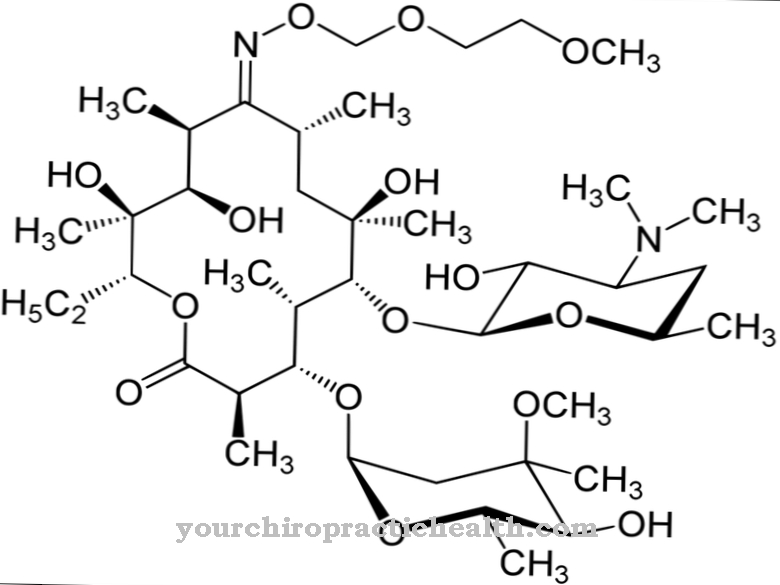At Bupivacaine it is a pharmacological agent that belongs to the category of anesthetics. The drug bupivacaine is a local anesthetic and belongs to the so-called amide type. The active ingredient is used, among other things, as a racemate. Bupivacaine is characterized by a comparatively slow onset of action.In addition, the effect of the drug lasts for a relatively long time, up to twelve hours.
What is bupivacaine?
The drug bupivacaine is primarily used as part of local anesthesia as well as anesthetizing entire areas of the body. It is used for conduction anesthesia and infiltration anesthesia. In the case of conduction anesthesia, nerve cords are numbed, while in infiltration anesthesia the active ingredient bupivacaine is injected into the tissue to relieve local pain.
The drug bupivacaine is also used in pain therapy. In addition, the active substance is used to switch off the sympathetic nerve, as this can reduce pain associated with this nerve.
Unlike the active ingredients mepivacaine and lidocaine, the drug bupivacaine is lipophilic. If it gets into the blood, 96 percent of the active ingredient binds to certain plasma proteins. In principle, the drug takes effect relatively slowly. The so-called plasma half-life is on average around five and a half hours. Because of this, bupivacaine is able to work for up to twelve hours. The active ingredient is then excreted through the kidneys.
Pharmacological effect
The drug bupivacaine is characterized by a characteristic mode of action in the human organism. First, the drug causes a change in the permeability of cell membranes. This change is particularly relevant for sodium ions. As a result, these are no longer able to flow into the cell, which is why an action potential can no longer form. This means that pain can no longer be felt in the corresponding area.
The active ingredient bupivacaine is primarily a drug for local anesthesia. The substance blocks nerve fibers in the vegetative nervous system over a longer period of time, whereby the blockage is not permanent, but reversible.
In addition, the active ingredient is able to temporarily switch off special sensory nerves and those that control movements. The drug bupivacaine can even numb the nerve fibers that control how the heart works.
The drug bupivacaine is believed to work by blocking the channels for the sodium ions within the walls of nerve cells. The influx of these ions plays an important role in the electrical polarity reversal in the nerves, which is what makes the conduction of stimuli possible. Dense sodium channels do not allow any corresponding ions into the nerve cell, so that no electrical voltage can build up.
In the majority of cases, the active ingredient bupivacaine occurs in the form of bupivacaine hydrochloride, a salt. In this state, the drug first reaches the nerve cell and develops its effect there. If the environment is very acidic, as is the case with inflamed areas, for example, bupivacaine hydrochloride does not split into its two basic components. For this reason, no analgesic effect is possible in such a case.
Medical application & use
The drug bupivacaine is primarily used in the context of anesthesia. It is mainly used for anesthesia procedures that are close to the spinal cord. These include, for example, epidural or spinal anesthesia.
Due to the relatively long-lasting effect, the drug bupivacaine is a very frequently used local anesthetic. In contrast, it is used less often in dentistry. Here it is primarily used for very long treatments.
Bupivacaine is also used as part of conduction and infiltration anesthesia. In principle, the active ingredient is suitable for the temporary elimination of severe to very severe pain in various areas of the body.
You can find your medication here
➔ Medicines for painRisks & side effects
The drug bupivacaine has undesirable side effects that should be considered before using the active ingredient. Basically, it should be noted that bupivacaine is a very toxic local anesthetic. This toxicity becomes particularly problematic with uncontrolled intravenous injection.
Possible side effects and symptoms of the drug bupivacaine include, for example, dizziness and hypotension or hypertension. Affected patients may experience nausea and vomiting. More serious side effects include arrhythmias or bradycardia.
In addition, so-called palpitations are possible while taking the drug. In some cases, the patients experience convulsions. In addition, hearing and vision disorders as well as speech disorders are possible. Sometimes there are also hypersensitivity reactions to bupivacaine, which manifest themselves, for example, in diarrhea or asthma attacks.
In certain cases, administration of the active ingredient bupivacaine is contraindicated. This includes, for example, an existing hypersensitivity to so-called acid amides. Even with low blood pressure (hypotension) or decompensated heart failure, the drug should not be used if possible.
Other contraindications include blood clotting disorders, hypovolemia and increased intracranial pressure during epidural anesthesia.












.jpg)



.jpg)










.jpg)
